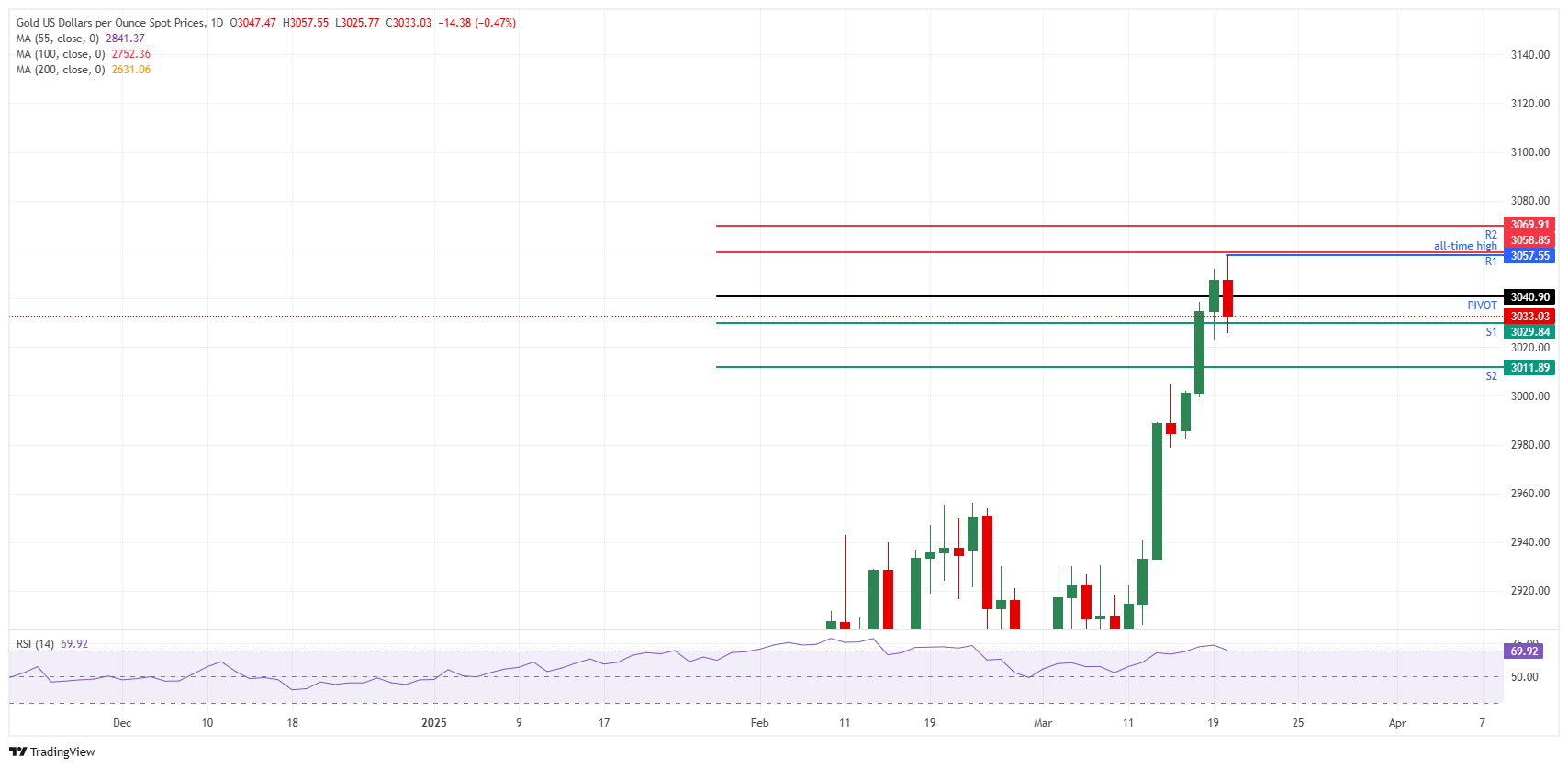- Gold already reached a new historical maximum of 3,057 $ this Thursday.
- The operators returned to gold after Powell said that tariffs should only delay the inflation target.
- Gold should continue supported by geopolitical uncertainty, since tensions remain in Gaza and Türkiye.
The price of gold (Xau/USD) has reached another new historical maximum in 3,057 $ and is currently about $ 3,032 at the time of writing on Thursday. Despite some sales pressure for profits, the previous increase occurred after the decision of interest rates of the Federal Reserve (FED) during the night, where the Central Bank kept the rates without changes in the range of 4.25%-4.50%. The president of the FED, Jerome Powell, reiterated that tariffs should only be a time delay to achieve the target of inflation.
Meanwhile, on the geopolitical front, tensions are increasing in Gaza and Türkiye. Israeli attacks continue in Gaza while the population is called to be relocated, since land offensive operations could be launched soon. Mass protests broke out in Türkiye after the arrest of the mayor of Istanbul, Ekrem Imamoglu, the main political rival of President Tayyip Erdogan.
What moves the market today: stay in the plan
- During the Federal Reserve meeting, President Powell said that his base case is that any increase in tariff inflation will be “transitory”, but then added that it will be very challenging to say with confidence how much of inflation comes from tariffs compared to other factors. He also said that the chances of recession have increased, although they are not high, Bloomberg reports.
- Swiss gold exports to the US remained elevated in February in 147.4 tons, for a value of more than 14,000 million dollars, reports Reuters.
- The Chinese media are advising investors to be cautious with gold, since prices will probably be volatile in the future, according to a report published in the China Securities Journal on Thursday. Precious metal prices are elevated due to geopolitical uncertainties and a rapid global economic environment; Investors should diversify assets, balance risks and avoid blindly pursued higher prices, Bloomberg reports.
Technical analysis: buying the fall continues to work
Gold seems to be operating in a very easy narrative for now, where operators are more than happy to buy each brief fall. A similar pattern was already seen on Monday and Wednesday this week. However, the risk grows for a Squeeze soon, which should eliminate short -term positions.
As for the technical levels, the new historical maximum of 3,057 $ is the first level to win. The following objective for this Thursday is the R1 resistance at 3,058 $, just below the round number of 3,060 $. If the latter breaks, then the resistance R2 is at 3,069.
Downward, the intradic pivot point at $ 3.040 is the first line of defense, followed by S1 support about $ 3,030 before the level of $ 3,000.
Xau/USD: Daily graphic
FAQS GOLD
Gold has played a fundamental role in the history of mankind, since it has been widely used as a deposit of value and a half of exchange. At present, apart from its brightness and use for jewelry, precious metal is considered an active refuge, which means that it is considered a good investment in turbulent times. Gold is also considered a coverage against inflation and depreciation of currencies, since it does not depend on any specific issuer or government.
Central banks are the greatest gold holders. In their objective of supporting their currencies in turbulent times, central banks tend to diversify their reserves and buy gold to improve the perception of strength of the economy and currency. High gold reserves can be a source of trust for the solvency of a country. Central banks added 1,136 tons of gold worth 70,000 million to their reservations in 2022, according to data from the World Gold Council. It is the largest annual purchase since there are records. The central banks of emerging economies such as China, India and Türkiye are rapidly increasing their gold reserves.
Gold has a reverse correlation with the US dollar and US Treasury bonds, which are the main reserve and shelter assets. When the dollar depreciates, the price of gold tends to rise, which allows investors and central banks to diversify their assets in turbulent times. Gold is also inversely correlated with risk assets. A rebound in the stock market tends to weaken the price of gold, while mass sales in higher risk markets tend to favor precious metal.
The price of gold can move due to a wide range of factors. Geopolitical instability or fear of a deep recession can cause the price of gold to rise rapidly due to its condition of active refuge. As an asset without yield, the price of gold tends to rise when interest rates lower, while the money increases to the yellow metal. Even so, most movements depend on how the US dollar (USD) behaves, since the asset is quoted in dollars (Xau/USD). A strong dollar tends to keep the price of gold controlled, while a weakest dollar probably thrusts gold prices.
Source: Fx Street
I am Joshua Winder, a senior-level journalist and editor at World Stock Market. I specialize in covering news related to the stock market and economic trends. With more than 8 years of experience in this field, I have become an expert in financial reporting.








